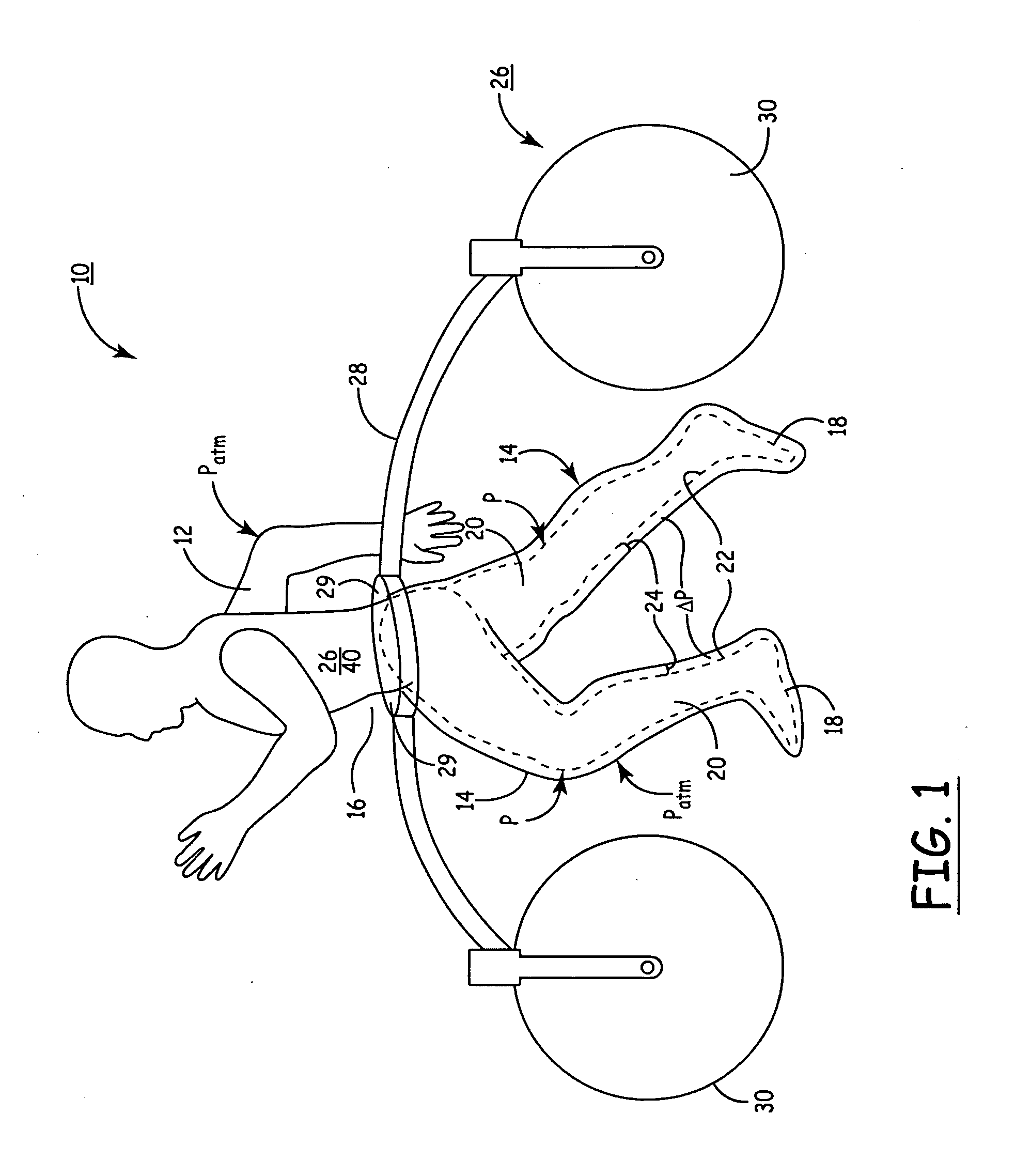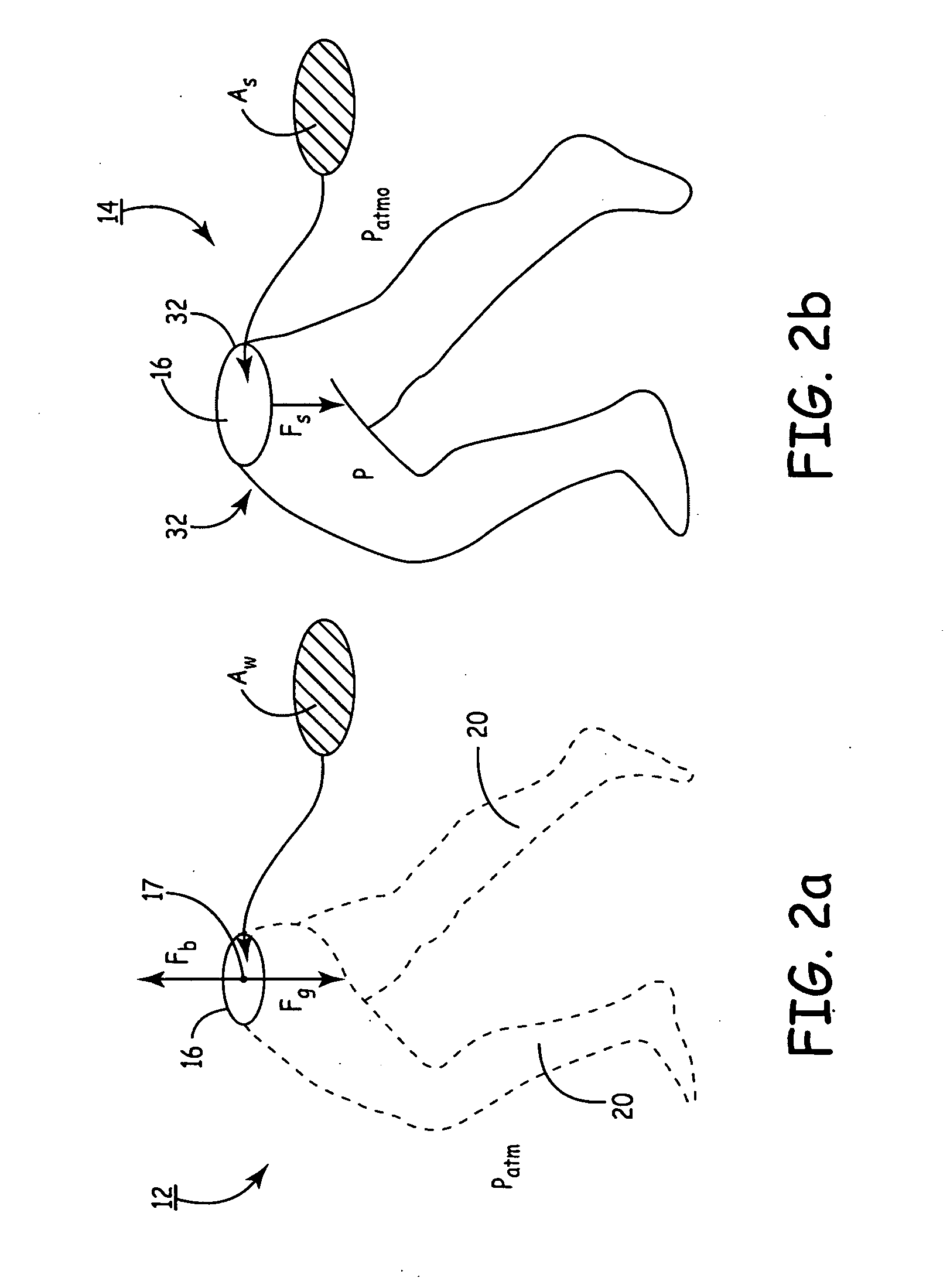Portable system for assisting body movement
a technology of assisting body movement and portable system, which is applied in the field of mammalian body motion and physical health, can solve the problems of damage to body bones or joints, injury, damage to body joints, etc., and achieve the effects of reducing the weight of the body, being convenient to carry, and facilitating the mobility of the physically disabled
- Summary
- Abstract
- Description
- Claims
- Application Information
AI Technical Summary
Benefits of technology
Problems solved by technology
Method used
Image
Examples
example 1
[0201]A working model of pressure shorts (waist to above the knees) to reduce the effective body weight of an individual was constructed and tested as follows. Shorts were sewn using airproof, rubberized nylon material (Harris Canvas, Minneapolis, Minn.), following a standard shorts pattern with legs extended to reach just above the knees. Seals were created above each knee by obtaining commercially available compression leggings. The leggings were made airtight by applying a complete coat of seam sealer (Seam Lock sold by REI, Inc. of Sumner, Wash.). The leggings were worn by the test individual from mid-thigh, and they terminated just above the knee joint. Each legging was interfaced to a leg of the nylon exterior shorts by placing each over a 7″ diameter steel ring, and then clamping together with a worm gear of said diameter. This was done for expediency. In a commercial application, this union would simply be sewn together, and seam sealed. The waist seal was constructed using ...
example 2
Prototype Pressurizing Suit
[0204]A prototype pressurizing suit extending from the waist to around the feet having an air bladder-type seas was constructed. The suit was constructed of two neoprene waders sized large and extra-large. The neoprene waders were both waterproof and airproof. The smaller waders were placed inside the larger-sized waders. The waders were fastened together at the waist using an epoxy adhesive to form an airtight seal. This formed an airproof compartment between the outer wader and the inner wader, which could be pressurized. When pressurized, the inner wader formed a seal against the body; the outer wader formed the pressurized body suit. An automobile air valve was attached to the outer wader to allow the unit to be pressurized.
[0205]The body suit was pressurized using a standard air compressor. A hose from the air compressor was attached to the valve in the suit. When pressurized, the user could feel pressure on his legs and reduced force on his legs. Mo...
example 3
Pressurized Leg Unit
[0207]A pressurized leg unit extending from the thigh to around the foot was constructed. The unit was constructed as follows: A waterproof hip wader was fitted tightly over a section of plastic PVC pipe. The pipe had an inner diameter slightly larger than the user's thigh. An airtight seal was formed between the leg and the neoprene. On the top of the unit, an inner seal was formed by applying neoprene to the inner diameter of the PVC tube to a sufficient thickness, so that a tight airtight seal was formed between the neoprene and the user's thigh. A pressure hose fitting was attached to the PVC pipe to allow the unit to be pressurized. The unit was pressurized to less than 3 psi. The pressure was sufficient that the user noticed a reduction in weight and pressure on his foot.
PUM
 Login to View More
Login to View More Abstract
Description
Claims
Application Information
 Login to View More
Login to View More - R&D
- Intellectual Property
- Life Sciences
- Materials
- Tech Scout
- Unparalleled Data Quality
- Higher Quality Content
- 60% Fewer Hallucinations
Browse by: Latest US Patents, China's latest patents, Technical Efficacy Thesaurus, Application Domain, Technology Topic, Popular Technical Reports.
© 2025 PatSnap. All rights reserved.Legal|Privacy policy|Modern Slavery Act Transparency Statement|Sitemap|About US| Contact US: help@patsnap.com



